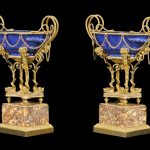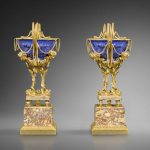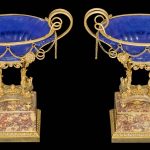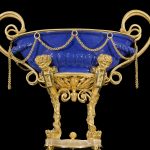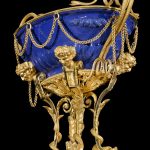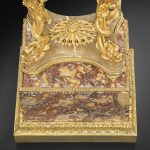The marquise de Beringhen’s goût arabesque ‘Terre de Perse’ vases
A pair of Louis XVI goût arabesque gilt bronze-mounted blue-glazed ‘Terre de Perse’ vases – circa 1785
The blue-glazed vases in ‘Terre de Perse’, Persia, Safavid Period, or Nevers faïence, second half 17th Century
Height: 35.5 cm. (14 in.) Width of handles: 28.5 cm. (11 ¼ in.)
Width of vases: 21.5 cm. (8 ½ in.) Depth of vases: 14.5 cm. (5 ¾ in.)
The oval-shaped vases in blue-glazed ‘Terre de Perse’, decorated with gadroons and horizontal handles forming a spiral and mounted in gilt bronze. Each supported by four rich consoles in arabesque style with a faun’s head on a foliated console ending in a dolphin whose tail wraps around each stem. The mounts underneath the vases decorated with openwork corbels and carried by four matte gilded leafy scrolls with seeds. The handles formed by double coiled snakes whose heads rest on the lip of the cup, where chains suspended from small rings adorn the entire oval perimeter. The four consoles rest on a contoured onyx socle centred by a rosette and fruiting finial and on four small toupie feet. The whole is placed on a stepped square base in brocatelle d’Espagne marble bordered with foliage.
Provenance
Collection of Angélique-Sophie de Hautefort, marquise de Beringhen (1702-1789), Paris
Combining rare marbles and exquisitely chased gilt bronze mounts, these objects are characterized by the richness of their ornaments and the rarity of the blue-ground ceramic described as ‘Terre de Perse’ by experts throughout the 18th Century. This is a fine and light ceramic body with a cobalt blue glaze. As its name suggests, it was originally thought to have originated in Persia, under the Safavid dynasty, during the second half of the 17th Century. Indeed, with the closure of the Chinese market in 1659, Persian ceramics took off again to satisfy the European market and attempted to imitate the porcelain production of the Far East. Recent research would indicate a strong possibility that the material was imitated in one of the faïence workshops in Nevers in the second half of the 17th Century.[1]
[1] Jean Rosen illustrates a bowl of a near-identical form with scrolling handles discovered in excavations in La Faïence de Nevers 1585-1900, Dijon, 2009, vol. 2, p. 243, fig. 360.

